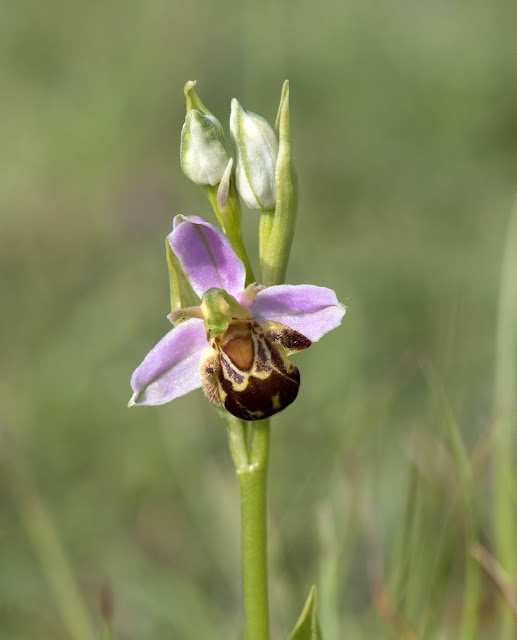Birders look away now - this blog is all about plants!
Most of my trips out with the camera are about birds or butterflies, occasionally other insects get some attention but a day hunting for orchids is a bit of a rarity. So, when Greenwings advertised a day out with Jon Dunn, he of Orchid Summer fame, then I grasped the opportunity and signed up straight away.
I rose early on a fine day and made my way via extremely quiet motorways to deepest, darkest Kent.The Royal Wedding was distracting everyone and I guessed it would be quiet everywhere, a double bonus as a long day in the field meant that I would avoid all the television coverage - bliss.
I arrived in the charming village of Wye, just east of Ashford, parked up and went for a stroll around the churchyard. Hopes of a Redstart or Spotted Flycatcher amongst the forest of headstones were dashed so I occupied the visitor's bench and waited for the others to arrive. Andy and Sally arrived to keep me company and we chewed the fat about nature matters until Jon herded us all together into the mini bus and we were off.
All the venues we visited have public access, most are well known and we made no visits to private land. Of course what we did have was Jon, whose knowledge is immeasurable and Alfie, the man with the deep local gen.
What follows is my photo-diary of the day, all in chronological order, probably far too many photos for a blog.
First stop was Denge Wood and the aptly named " Bonsai Bank" so named due to an unsuccessful attempt to grow conifers. No matter it is now a stunning location for Lady Orchids, here there are hundreds. With a supporting cast of Early Purple, Common Twayblade, Greater Butterfly and White Helleborine it could keep the enthusiast occupied for a day - or more.
 |
| Lady Orchid, Orchis purpurea |
 |
| Lady Orchid, Orchis purpurea |
 |
| Lady Orchid, Orchis purpurea, a light "champagne" coloured specimen |
 |
| Lady Orchid, Orchis purpurea |
 |
| Lady Orchid, Orchis purpurea |
 |
| Lady Orchid, Orchis purpurea, a really dark specimen |
 |
| Lady Orchid, Orchis purpurea, a really dark specimen |
 |
| It seemed that those growing in shade developed more "spots" |
 |
| The spots are composed of tufts of papillae |
 |
| Supposedly like "Angels" |
 |
| Lady Orchid, Orchis purpurea, var albida |
 |
| Lady Orchid, Orchis purpurea, var albida - using Andy's black trousers as a background. |
 |
| Finally - the largest spike I could find. |
 |
| A tad early for the Greater Butterfly Orchids, Platanthera chlorantha |
 |
| Similarly for the White Helleborine, Cephalanthera damasonium |
 |
| Though I managed to record one open bloom. |
 |
| Common Twayblades, Neottia ovata were everywhere - spiders love them. |
 |
| Common Twayblade |
 |
| Common Twayblade |
 |
| Common Twayblade |
Butterflies added an extra dimension, Duke of Burgundy, Green Hairstreak and Brimstones all on the wing.
 |
| Duke of Burgundy |
 |
| Green Hairstreak |
For balance, having seen so many Lady Orchids it was time to record some Man Orchids, Orchis anthroprophora. |
| Man Orchid, Orchis anthroprophora |
 |
| Man Orchid, Orchis anthroprophora |
 |
| Man Orchid, Orchis anthroprophora |
 |
| Man Orchid, Orchis anthroprophora |
After all the excitement it was nice to have a lunch break at the Tickled Trout in Wye, then it was back out on the trail.
The first venue in the afternoon kicked off the excitement all over again, a single specimen of the rare Late Spider Orchid, Ophrys fuciflora conveniently in bloom early.
 |
| Late Spider Orchid, Ophrys fuciflora |
 |
| Late Spider Orchid, Ophrys fuciflora |
 |
| Late Spider Orchid, Ophrys fuciflora |
 |
| Late Spider Orchid, Ophrys fuciflora |
 |
| Late Spider Orchid, Ophrys fuciflora |
 |
| Late Spider Orchid, Ophrys fuciflora |
 |
| Queuing patiently to record a rarity. |
After that we just had to find Early Spider Orchid, Ophrys sphegodes most of the specimens we found were just past their best, top blooms only in reasonable condition. |
| Early Spider Orchid, Ophrys sphegodes |
 |
| Early Spider Orchid, Ophrys sphegodes |
 |
| Early Spider Orchid, Ophrys sphegodes |
The final venue gave us Monkey Orchids, Orchis simia, Fly Orchids, Orchis insectifera and some fresher Early Purples, Orchis mascula.
 |
| Monkey Orchid, Orchis simia |
 |
| Monkey Orchid, Orchis simia |
 |
| Monkey Orchid, Orchis simia |
 |
| Monkey Orchid, Orchis simia |
 |
| Early Purple Orchid, Orchis mascula |
 |
| Fly Orchid, Orchis insectifera |
 |
| Fly Orchid, Orchis insectifera |
 |
| Fly Orchid, Orchis insectifera |
 |
| Fly Orchid, Orchis insectifera |
 |
| Fly Orchid, Orchis insectifera |
 |
| Fly Orchid, Orchis insectifera |
 |
| Fly Orchid, Orchis insectifera |
 |
| Fly Orchid, Orchis insectifera |
Then we had run out of time, arriving back in Wye after 18:00, the end of a great day. Though I have a suspicion that most of us would have carried on until dark.


























































































